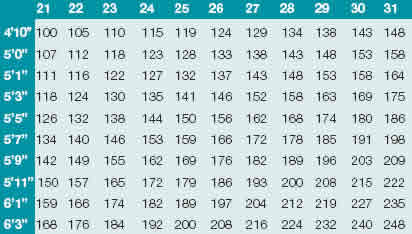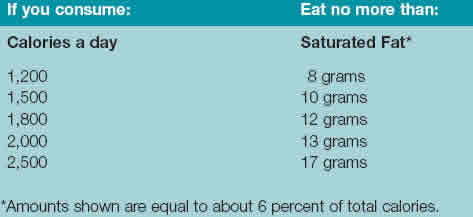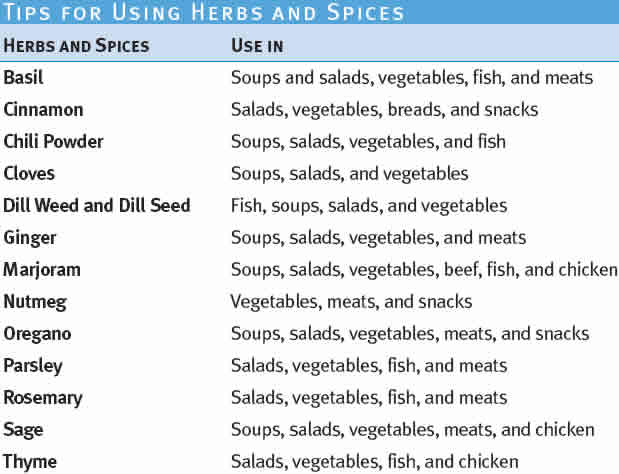Foods to Eat to Lower Cholesterol and Blood Pressure!
Both high cholesterol and high blood pressure cam be harmful for your cardiovascular system. They can be a great combination to cause lots of complications in long term, particularly such as heart disease, heart attack, and stroke. And many times, factors that can lead to high cholesterol also can trigger your blood pressure to rise. For instance, most foods that can increase your blood pressure also do the same way to the levels of your LDL and triglyceride. So, what you should avoid and eat to prevent and treat both problems?
Foods that you eat can significantly affect how far the levels of your cholesterol and blood pressure will go. But don’t forget to other risk factors, particularly such as your weight. Both overweight and obesity can be bad for the blood flow in the body.
More scale weight that you gain, the greater risk of developing hypertension and high cholesterol, especially true if most of your weight is fat – not lean muscles.
Your heart will work harder to pump the blood all around your body when you gain more fats. Furthermore, both overweight and obesity are often found together with unhealthy habit of eating more saturated fat, trans-fat, and cholesterol from the diet. These foods are not only poor in nutrient but also high in calories.
According to a guideline published by National Institutes of Health (NIH), if your body mass index (BMI) is around 25 to 29.9, this can be categorized into overweight. And if your BMI is 30 or higher, you are now categorized into ‘obese’. The normal BMI should be around 18.5 to 24.9.
If you have normal BMI, you need to maintain your weight. But if you are overweight or even obese, losing weight can be so helpful to improve your entire health – either for your blood flow. See also how losing weight can help lower blood pressure and cholesterol in the previous post!
Below is a helpful table to get to know your BMI. Just use your current height and weight (without shoes and with underwear), you can get the answer of your BMI by using the following table (Table source: NIH):
High-saturated foods have a significant contribution in increasing your cholesterol. Even they can give greater bad impact than high-cholesterol foods.
Moreover, saturated fats in the diet also play a key role in increasing your blood pressure. And typically, they are also high in calories (as noted before) which can be bad for your weight control. Therefore, it’s important to limit them in the diet.
Saturated fat – what actually is it?
It is much familiar called as bad fat. It consists of many unhealthy fatty deposits that can harm your cardiovascular system. In general, it is solid both in room and meat safe (refrigerator) temperature. It is more common to be found in animal-food products, particularly such as in the skin of poultry, lard, fatty cuts of meats, and whole-milk products. It is also in greatest amounts in some types of vegetable oils such as palm and coconut oils.
Many studies have confirmed that too much consumption of saturated fat can increase LDL (bad cholesterol – for more detailed information about types of cholesterol, click here). Heart disease, high blood pressure, and high cholesterol are more common in population that sticks with diet high in saturated fat.
Both TLC diet (a kind of diet designed to lower cholesterol) and DASH diet (a diet specially designed to lower blood pressure) recommend limiting saturated fat.
The table below tells the safe amount of saturated fat that you have to follow (table source: NIH)
Trans-fat foods (trans-fatty acids)
Like saturated fat, trans-fat foods are also bad for your cardiovascular system. It is usually found in hydrogenated foods. Hydrogenation is a term used to call the process of hydrogen that is added to non-saturated fat. As a result, the unsaturated that is added with hydrogen can be more solid & stable at room temperature – this can covert unsaturated fat to become saturated fat.
Trans-fat is commonly found in fried foods or foods contain harder shortening /margarine (made with hydrogenated vegetable oils). It also can be naturally found in animal fats (like some meat and high-fat dairy products).
So, it’s not only about what kind of food that you put on your mouth. You need also concern on how to cook your foods healthfully. The table below can be one of nice guides for your healthy cooking methods to get your best and healthiest levels for your cholesterol and blood pressure:
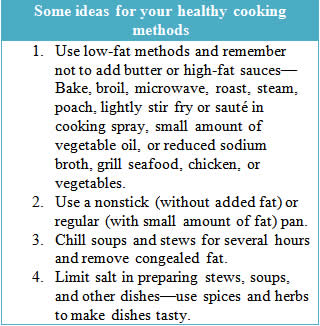
How about unsaturated fats
Unlike saturated fat and trans-fat, unsaturated fat is much healthier – even it can help lower LDL. It is typically liquid at refrigerator & room temperature. In general, there are two types of unsaturated fats:
- Polyunsaturated fats which are commonly found in the foods from plant such as soybean, some kinds of nuts, corn, safflower, and so on.Omega-3 fatty acids found in fish also can be categorized into polyunsaturated fats. And as well we know, there are lots of healthy advantages from eating omega-3 fatty acids.
- Monounsaturated fats. Olive oil, peanut oils, and avocados are some foods from plants that are high in monounsaturated fats.
As the name implies, foods high in cholesterol can affect your cholesterol levels – though the impact is not as much as when you eat foods high in saturated fats.
And in fact, Foods high in saturated fats and cholesterol are often found together in the same foods. Therefore, if you restrict your diet from saturated fats, this can also help limit your cholesterol intake. Egg yolk (but not for white egg), organs of poultry and animals (such as liver), and whole milk dairy products (like cheese and butter) are high in cholesterol.
Actually, your body is not really able to digest fiber (both soluble and insoluble fiber). In other words, it doesn’t absorb into your bloodstream.
Getting plenty of fiber is very crucial to improve your entire health, particularly for your digestive system. Fiber is also great for your weight control – eating fiber can provide a steady energy because you will not get hunger too fast. And as mentioned before, having healthy weight is great to control both your blood pressure and cholesterol.
But when it comes to improving the health of your heart and cardiovascular system, soluble fiber is the best choice, because it can help decrease the amounts of your LDL in the bloodstream.
And if your LDL keeps on its healthy level, your risk of high blood pressure decreases. Soluble fiber can inhibit the absorption of bad fatty deposits and cholesterol from the wall intestine to the bloodstream.
However, this doesn’t mean you need to only focus eating more soluble fiber and can ignore your insoluble fiber intake. Insoluble fiber is also important for your entire health, particularly for the health of your colon. So make sure you get plenty of both soluble and insoluble fiber in the diet!
And if you get used with diet poor in fiber, don’t jump directly to drastically increase your fiber intake. It’s much more recommended to increase your fiber intake gradually until you reach the level of appropriate amounts of fiber that your body needs. In TLC diet, the intake of soluble fiber should be about 5-10 grams per day.
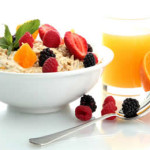 Below are some ideas on how to boost your soluble fiber intake with fun and easily:
Below are some ideas on how to boost your soluble fiber intake with fun and easily:
- Cold or hot oatbran and oatmeal can be good choice to start your day. Remember that it’s important to not skip your breakfast! With breakfast, you can control on what you eat in the next meals. And this can be helpful to control your calories, either for other essential nutrients that your body needs to help lower your blood pressure and cholesterol.
- If you like cereal, you can combine with some foods high in soluble fiber such as banana, berries, grapes, and apple (these foods are rich in pectin that can be very helpful to lower LDL).
- Prioritize eating the whole fruits instead of taking a fruit juice! For instance, if you take a glass of orange juice, it provides fewer fiber than if you choose to eat the whole form of the fruit.
- And if you love salads, you can use lentils, beans, and other choices that high in soluble fiber.
Other good sources of soluble fiber include beans, seeds, and barley. And if necessary, you can consider taking soluble supplements such as psyllium. But to keep safe, consult first with a doctor before taking any supplement!
Since having healthy weight is important for both your cholesterol and blood pressure, it’s not only about foods low in saturated fat and cholesterol but you need also to keep concern on the calories of each food that you put in your mouth.
You may be tempted to eat more specific foods because you believe that they are healthy and good for your health. If so, don’t do it otherwise it can be counterproductive for your weight control.
Even healthy foods such as fruits and vegetables also contain calories. Calorie is calorie, and you cannot change it whatever its source. Therefore, make sure you eat anything appropriately – keep an eye on the portion size!
Most foods that you eat contain carbohydrate – even fruits and vegetables contain carbohydrate (though in small amounts).
And since it’s important to have healthy weight when it comes to controlling and lowering both blood pressure & cholesterol, most of your carbohydrate should be complex carbohydrate! Complex carbohydrate is typically rich in fiber and lower in calories if compared with simple carbohydrate.
Excessive consumption of salt can be bad for both blood pressure and cholesterol. Salt is naturally found in some whole foods, but in small amounts. In general, most of your sodium and salt intake come from the processed foods that are added with salt.
Why salt and sodium is bad for your blood pressure and cholesterol?
The reason is due to the ability of salt that can retain the water. If you get too much salt from your diet, this increases your chance of retaining more fluid in your body.
As a result, there will be greater volume of blood that flows through the arteries. And it can increase the blood pressure – which then eventually put you at high risk of developing high cholesterol.
How to reduce salt and sodium in the diet?
Fortunately, there are plenty options of salt substitutes that you can explore without sacrificing your flavor. The table below is some helpful ideas to replace salt with different choices of spices and herbs.
Omage-3 fatty acids (a kind of unsaturated fat) may not directly affect the levels of your blood pressure and cholesterol. But remember, one of the major goals why you need to maintain your cholesterol and blood pressure is to help improve the health of your heart.
That’s why many doctors also recommend eating plenty of omega-3 fatty acids for patients with hypertension and high cholesterol. However, foods high in omega-3 fatty acids such as tuna and salmon also contain calories.
So again, you need to eat them moderately. Try to eat them for about 2 fish meals per week. But if for pregnant women, fish high in mercury must be avoided because can harm their pregnancy and themselves.
Both stanols and sterols can be found naturally in many plants – but in small amounts. For instance, you can find them in food products that are taken from tall pine-free oils and soybean. They also can be combined with a small amount of canola oil to make various foods.
You can also find them in foods fortified with stanols and sterols such as some types of margarine, chocolate, orange juice, and granola bars. Moreover, they are available in supplements.
According to an article published on the Harvard Health Publications, sterols and stenols may help decrease LDL without affecting triglyceride and HDL.

